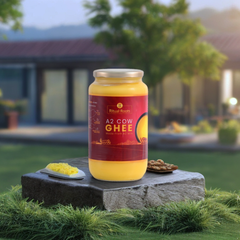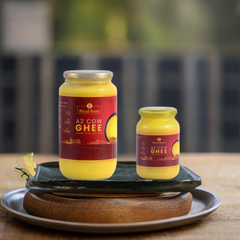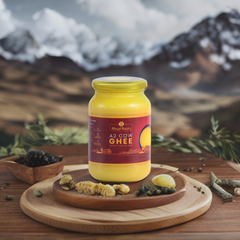
Cultured Ghee Benefits That Make It Better Than Traditional Ghee
Cultured ghee and traditional ghee are often used synonymously, but not everyone knows about the difference between them. While both cultured ghee and traditional ghee share similarities in terms of flavor and culinary applications, they differ significantly in their production methods and nutritional profiles. So, grab a cup of chai (tea), sit back, and submerge into this flavorful journey that is sure to tantalize your taste buds and enlighten your wellness-seeking soul.
The Process Of Cultured Ghee
Cultured ghee undergoes a bilona ghee-making process that sets it apart from traditional ghee. This meticulous method involves fermenting butter before converting it into ghee. Here's a closer look at the step-by-step process of crafting this delightful delicacy:
Culturing the Butter:
To create cultured ghee, high-quality butter is first cultured by introducing live bacterial cultures. These cultures are typically derived from yogurt or buttermilk. The butter is allowed to ferment at a controlled temperature, activating the beneficial bacteria in the cultures.
Fermentation Period:
During the fermentation period, the live cultures in the butter start to break down the lactose and casein, transforming the composition of the butter. This natural fermentation process results in the development of a unique flavor profile and enhances the nutritional qualities of the ghee.
Clarification:
After fermentation, the cultured butter is gently heated to separate the milk solids and water content from the butterfat. This process is known as clarification and plays a crucial role in creating the pure golden liquid known as ghee.
Skimming and Straining:
During the clarification process, the impurities in the butter rise to the surface, forming a foam or scum. Skimming this foam helps eliminate any remaining milk solids or impurities. The clarified butter is then strained to remove any residual particles, ensuring a smooth and refined texture.
Cooking and Aromatization:
Once the butter has been clarified and strained, it is heated again to a specific temperature to evaporate any remaining moisture. This cooking process imparts a rich, nutty aroma and deepens the flavor of the ghee.
Final Product:
After cooking, the liquid ghee is carefully transferred into containers and allowed to cool and solidify. The end result is luscious and velvety textured cultured ghee with a distinctive taste and an array of health-enhancing properties.
Cultured Ghee Benefits
Here are cultured ghee benefits that make it stand out from traditional ghee:
Enhanced Nutritional Profile
Cultured ghee takes the nutritional benefits of traditional ghee to a whole new level. The fermentation process involved in its creation enhances the bioavailability of essential nutrients. It becomes a rich source of vitamins A, D, E, and K and beneficial fatty acids. These nutrients play a crucial role in supporting overall well-being, boosting immunity, and promoting healthy skin.
Probiotic Benefits
One of the remarkable advantages of cultured ghee lies in its probiotic content. The live cultures introduced during the fermentation process promote a healthy gut microbiome. These beneficial bacteria aid in digestion, improve nutrient absorption and support a robust immune system. Adding cultured ghee to your meals can be an excellent way to incorporate probiotics into your diet.
Richer Flavor & Aroma
Cultured ghee unveils a distinctive flavor and aroma that can elevate your culinary creations. Fermentation adds depth and complexity, resulting in a nutty and slightly tangy taste. Whether you're sautéing vegetables, making dal, or preparing traditional Indian sweets, the richness and aromatic notes of cultured ghee bring a delightful twist to your dishes.
Easy To Digest
Cultured ghee offers a great alternative for those with lactose or casein sensitivities. The fermentation process breaks down lactose and casein, making it easier to digest compared to traditional ghee. Even individuals who are lactose intolerant may find that they can tolerate cultured ghee without any discomfort.
Shelf Stability
Cultured ghee boasts impressive shelf stability, allowing it to be stored at room temperature for extended periods without spoiling. The elimination of milk solids and water content during the clarification process ensures that it can resist spoilage and rancidity. This makes it a convenient pantry staple, especially in Indian households where ghee is used regularly.
Versatility in Cooking
Cultured ghee's versatility in the kitchen is unmatched. From traditional Indian dishes like biryani and butter chicken to baking bread and frying snacks, cultured ghee can be used in various culinary applications. Its high smoke point makes it ideal for deep-frying, while its rich flavor enhances the taste of curries, lentils, and even desserts like halwa and ladoos.
Shop For Purest Cultured Ghee At Ritual Roots
Experience the purest cultured ghee at Ritual Roots, where a culinary treasure awaits. At Ritual Roots, we pour our heart and soul into crafting each jar of cultured ghee with utmost care. We source the finest ingredients, including butter from grass-fed cows, ensuring that our ghee embodies exceptional quality. Following the time-honored tradition of natural fermentation using live cultures, our ghee carries a unique flavor profile and heightened nutritional value.
We take pride in maintaining rigorous quality assurance measures to deliver organic India ghee, a product that exceeds expectations. By choosing Ritual Roots, you join us in our commitment to sustainability and responsible sourcing. Immerse yourself in the richness of Indian culture, tradition, and flavor with our pure cultured ghee, lovingly made for you to savor and enjoy.
Indulge in the pure delight of Ritual Roots' cultured ghee - Improve your culinary experience today!
-

A2 Cow Pure Ghee , Desi Gir Cow (1 KG)
Rs. 2,470.00 -

A2 Cow Pure Ghee , Desi Gir Cow (1.5 KG)
Rs. 3,700.00 -

A2 Cow Pure Ghee , Desi Gir Cow (500gm)
Rs. 1,350.00


